Culture
Men In Skirts?
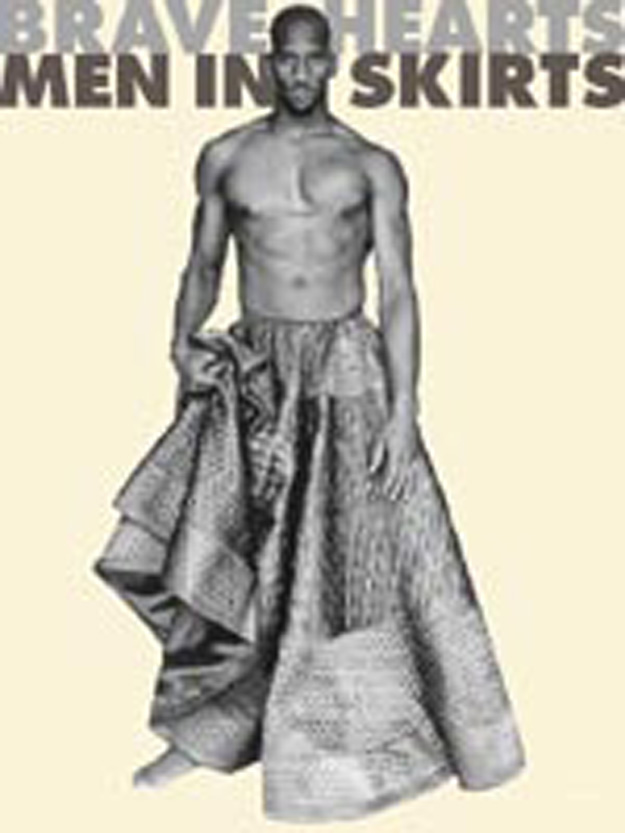
Photo courtesy Metropolitan Museum of Art.
The Metropolitan Museum of Art is hosting an exhibit titled, Bravehearts:
Men in
Skirts. The title was inspired by the Mel Gibson film, Bravehearts,
depicting the battles
of the Scotts for freedom from English rule.The exhibit will run from
November 4, 2003–February 8, 2004.
It will be displayed in The Costume Institute, ground floor. Their website
describes the exhibit this
way: Bravehearts locates “men in skirts” in historical
and cross-cultural contexts and looks
at designers as well as individuals who have appropriated the skirt
as a means of injecting novelty
into male fashion, transgressing moral and social codes, and redefining
ideals of masculinity.
To which I say, “Huh?” Guys just want to be comfortable
and many men are discovering
that skirts are more comfortable for the male body than pants. Pants
bind and chafe.
They rub and restrict movement. There’s the “three drops”
problem caused by our
plumbing getting kinked on all that material. It’s even been demonstrated
that pants can
lower a man’s sperm count by raising the temperature of his testicles
which inhibits
sperm production. Cooling the testes with ice is a common medical treatment
to increase
sperm count and motility. Many urologists claim that tight pants can
even contribute to or
aggravate prostate problems.
Still, men have to overcome the social stigma of being considered effeminate
if they
wear anything other than pants. To head off that stigma, most men who
wear skirts wear
them in the form of kilts which are recognized by most European cultures
as a masculine
garment.
Far from being an attempt to transgress moral and social codes or redifine
ideals of
masculinity, modern kilt wearers are rediscovering what used to be a
normal mode of
dress for men.
It all started with a fig leaf. According to the Bible, Adam and Eve
found shame along
with knowledge and began covering their bodies. The fig leaf was the
first unisex
garment. Afterwards, humans began hunting animals and wearing their
skins. While the
fig leaf has fallen out of fashion, there are still people today who
wear the skins of dead
animals.
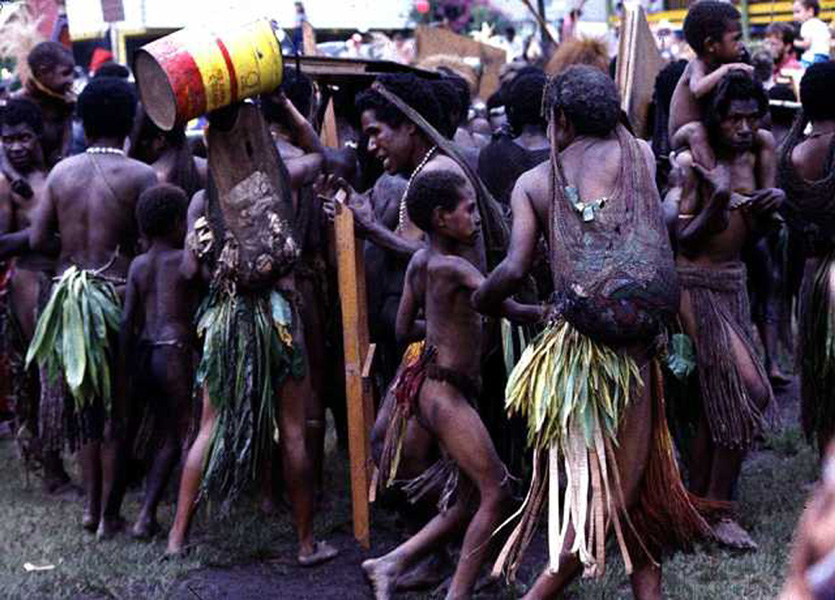
Not quite Eden, but contemporary Polynesian men and women wear
skirts made of plant materials. Source: http://gallery.sjsu.edu
Then came the agricultural revolution and people began weaving plant
materials into
cloth. Cotton was used extensively in the ancient Middle East. The word
comes from
the Arabic “qutun.”
-- In the Indus River Valley in Pakistan, cotton was being grown,
spun and woven into
cloth 3,000 years BC. At about the same time, natives of Egypt’s
Nile valley were making
and wearing cotton clothing.
Source: http://www.cotton.org/pubs/cottoncounts/story/index.cfm
Ancient Egyptians often went naked, but when they dressed, most Egyptians
wore
nearly-transparent linens made of flax. The clothes were light and loose-fitting
-- ideal for
the hot climate they lived in. It seems that the style of dress had more to do with
utilitarian needs than that of a fashion choice.
While the Egyptians did make decisions
on dress and adornment based on the fashion of the times their choices were also
impacted by their environment. It would be a wonder if given the option of a modern
dress suit they would choose it over the loose fitting and airy
linens they were
known to wear when dressing.
Men and women wore makeup -- the equivalent
of today’s
mascara, blush, lipstick and nail polish. In fact today’s makeup
styles are directly
derived from those of the Ancient Egyptians. The exception being that
very few men
wear makeup nowadays.
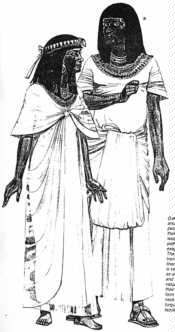 Ancient Egyptian men and women wore loose unbifurcated clothing.
Ancient Egyptian men and women wore loose unbifurcated clothing.
Source: http://www.dragonstrike.com/egypt/cloth.htm
The Greeks and Romans also wore loose clothing. Men and women wore
togas and
tunics (a long shirt that was tied or belted around the waist). The
longer and more
elaborate the cothing was, the higher the rank of the person wearing
it. Senators wore
long togas that hung down to the heels of their feet. A Knight wore
a tunic above the
knees. Soldiers wore short armored skirts, and laborers wore loincloths.
Tunics were
worn most often as everyday clothing using lighter or heavier material
to suit the
weather. Trouser-like garments were also worn, but were not very common.
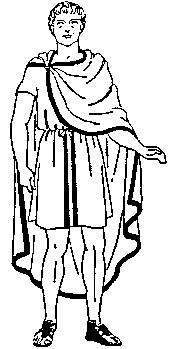
A young Roman Knight in tunic and cape.
-- http://www.dl.ket.org/latin1/things/romanlife/
Meanwhile, in other parts of the world men wore loincloths, kaftans,
daishikis, kanzu (a
long dress), aso oke (kaftan with pants and hat), tunics, grass skirts,
sarongs and
lava-lavas.
There were very few places in the world where men commonly wore pants.
The Vikings
were a notable exception. Viking men wore wool pants under a tunic.
In India, men
wore lungis (a short piece of cloth wrapped around the thighs, like
a sarong), kurtas,
dhotis (a longer lungi with the extra material pulled up between the
legs) and pyjamas
which are a trouser-like garment. While most modern Indian men wear
western styles of
clothing in the cities, villagers still wear the traditional wraps and
loose-fitting trousers.
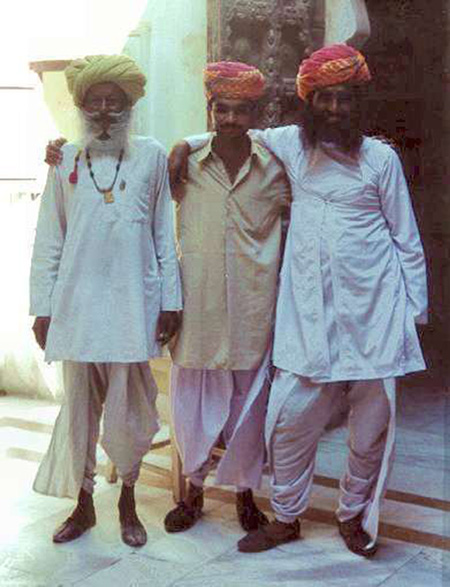
Rajasthan men in traditional village garments.
Source: http://ukoehler.bei.t-online.de/
In early Europe, men wore a variety of clothing styles. Near the end
of the ice-age, a
German man would wear a loin garment tied between the legs, stockings
made of animal
skins, a fur tunic and finally, a coat made of grass.
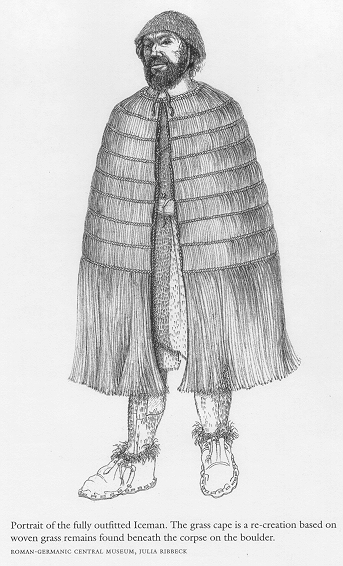
Early German man wearing a grass coat over a fur tunic with leggings
and loin cloth.
Source: http://agronomy.ucdavis.edu
Later, European men wore tunics over tight leggings that tied to a waistband
under their
clothing. In Scotland, men wore a blanket draped over the shoulders,
tucked (“kilted”)
around the waist and held in place with a wide belt. This was later
abbreviated to the
knee-length skirt that is commonly worn as ceremonial dress. Lately,
kilts are worn by
men who dare to challenge the notion that men should only wear pants.
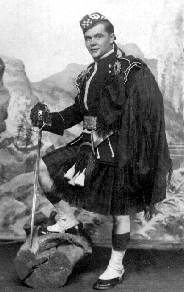
A young Scottish Highlander wearing a full formal kilt.
Source: http://www.emory.edu
But why did men start wearing pants in the first place?
It’s hard to find a serious history of men’s pants, but
it seems to have started with the Renaissance.
Up to that time, women wore pants adapted from Arabic clothing, and
it was thought to be unmanly
for men to wear them. But machines were being invented. Loose clothing
is not compatible with gears
and cogs and levers. The men who operated the machines needed clothing
that wouldn’t get caught in
the machinery and would likewise protect them from flying bits of wood
and metal. So, pants and leggings
became the standard wear of Renaissance laborers. Sewing machines eased
the manufacture of pants.
Short breeches and leggings became standard wear for European men who
brought their style of
dress to the New World. The practiced continued and spread during the
Industrial Age. Cowboys
and gold miners began wearing rugged pants made by a fellow named Levi.
Denim pants became
the standard wear of all laborers. Men and women wore Levi’s demin
jeans in those times just as they do now.
After two World Wars, wearing pants became a symbol of masculine power.
In America, the post-war
years saw men in pants and women forced back into skirts and dresses.
The question, “Who wears the pants?”
was asked of men when their authority was questioned. Women openly rebelled
in the 1960’s and 1970’s
and won back their right to wear pants whenever they wanted to.
Now, four-year-old girls “wear the pants” and so pants
no longer carry the symbolism of
masculine authority. Some modern men have decided that it’s time
men also had choices
in clothing again.
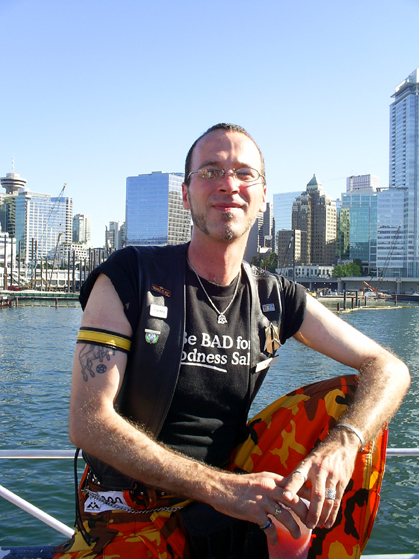
Kirk Ludden, Huntington, NY
Photo supplied by Mr. Ludden.
SJCC Times: What type of unbifurcated garment do you
wear?
Kirk: Utilikilts Neo Classic Originals & Workman's
SJCC Times: Why did you start wearing it?
Kirk: The FREEDOM & the look. Used to belong to
a Pipe & Drum Band, and couldn't wear the
band kilt when I wanted. So went out & got my own.
SJCC Times: How many such garments do you own?
Kirk: 6 and counting
SJCC Times: Where do you wear it?
Kirk: Anywhere & everywhere. Only wear pants when
working.
SJCC Times: What are the good points to wearing it?
Kirk: Freedom. Looks Good. Easy Access....LOL
SJCC Times: What are the drawbacks?
Kirk: mmmm.....VERY FEW.....cold knees in the winter.
Other comments: Montreal Gay Pride 1998 had the band
kilt & was attending pride.
There were those who wanted to see underneath, & I obliged. An Englishman
said to me,
"Do you know you are supposed to wearing underwear?". Kinda
threw me off guard, first
I heard that underwear had to be worn. So I said, "What?".
He explained, "When there is a
woman on the thorn, one wears underwear!" Without missing a beat
I responded, "That
makes no sense. If one is heterosexual, would think you would want to
screw the Queen & get
out leaving no evidence. Secondly, I am more Scottish & Irish then
I am English, so I don't
give a F*CK what the English say. Lastly, the head of the arm forces
in Great Britain was
asked by Parliament, "Do you wear underwear?". To which his
response was, "If they don't
issue it, we can't wear it!".
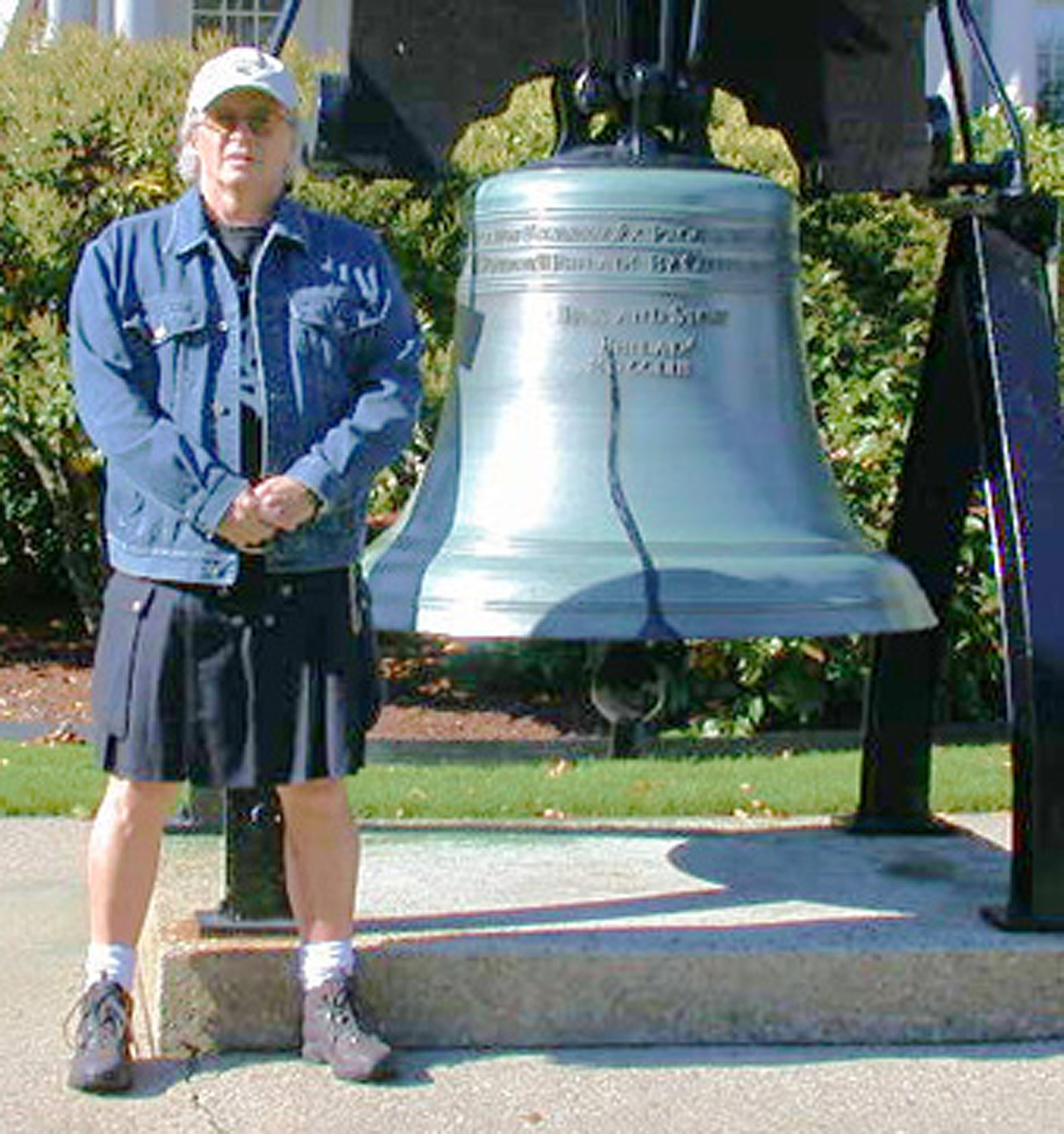
Richard D. Ackerman II, Gilford, New Hampshire
Photo supplied by Mr. Ackerman
SJCC Times: What type of unbifurcated garment do you
wear?
Richard: At this point I wear Utilikilts, and Kilts
mainly, with an occasional
skirt thrown in for the fun of it.
SJCC Times: Why did you start wearing it.
Richard: I guess the main reason is comfort. And also
I like to be a little
different and rock the boat a little. And also at my age the attention
from
the ladies is a bit of a bonus.
SJCC Times: How many such garments do you own?
Richard: I have five Utilikilts, one traditional 8
yard kilt in a Lennox District
Tartan, one traditional 4 yard casual kilt in a Medlin Tweed fabric,
and a
large number of denim and twill skirts all with pockets and front flies.
SJCC Times: Where do you wear them?
Richard: I wear Kilts, Utilikilts and skirts just
about everywhere except work only
because my work environment is not suitable for skirts or shorts.
SJCC Times: What are the good points to wearing it?
Richard: The biggest advantage is comfort. Next I
would have to say is the attention
they attract from the ladies. They are a great ice breaker and conversation
starter.
SJCC Times: What are the drawbacks?
Richard: The only real drawback as far as I can see
is that they are sometimes down
right cold in our New England winters also they really don't work very
well
for motorcycle riding or sailing on a good windy day.
Other comments:
I find Kilts and skirts to be a very practical, useful and comfortable
addition to my everyday wardrobe. And Iwould recommend that any guy
who
has not tried one doesn't know what he is missing.
If you are one of the Bravehearts looking for more choices in men's
clothing, here are some places to look at:
21st Century Kilts: http://www.21stcenturykilts.co.uk/
Afa Tasi: http://www.afatasi.com/men.html
Amerikilt: http://www.amerikilt.com
Amok: http://www.amok.ch/amok_e/home/index.htm
Bear Kilts: http://www.bearkilts.com
Get Shirty: http://www.getshirty.com/
Men In Time: https://ssl.kundenserver.de/menintime.de
Midas Clothing: http://www.midasclothing.com/
NeoKilts: http://www.neokilts.com/Index.html
Sport Kilt: http://www.sportkilt.com/
USA Kilts: http://www.usakilts.com/homepage.htm
Utilikilts: http://www.utilikilts.com/
Whitethistle: http://www.whitethistle.net/









